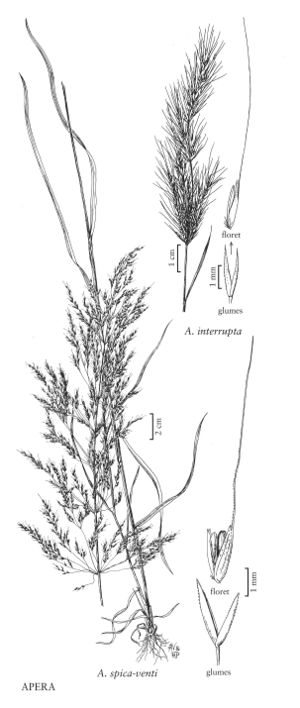Difference between revisions of "Apera interrupta"
FNA>Volume Importer |
imported>Volume Importer |
||
| (2 intermediate revisions by the same user not shown) | |||
| Line 4: | Line 4: | ||
|publications= | |publications= | ||
|common_names=Interrupted windgrass | |common_names=Interrupted windgrass | ||
| + | |special_status={{Treatment/ID/Special_status | ||
| + | |code=I | ||
| + | |label=Introduced | ||
| + | }} | ||
|basionyms= | |basionyms= | ||
|synonyms={{Treatment/ID/Synonym | |synonyms={{Treatment/ID/Synonym | ||
| Line 42: | Line 46: | ||
|publication title= | |publication title= | ||
|publication year= | |publication year= | ||
| − | |special status= | + | |special status=Introduced |
| − | |source xml=https:// | + | |source xml=https://bitbucket.org/aafc-mbb/fna-data-curation/src/200273ad09963decb8fc72550212de541d86569d/coarse_grained_fna_xml/V24/V24_1124.xml |
|subfamily=Poaceae subfam. Pooideae | |subfamily=Poaceae subfam. Pooideae | ||
|tribe=Poaceae tribe Poeae | |tribe=Poaceae tribe Poeae | ||
Latest revision as of 16:22, 11 May 2021
Culms (5)10-50(75) cm, weak, slender, solitary or with several shoots, sometimes sparingly branched above the base; internodes usually longer than the sheaths. Sheaths often purplish; ligules 1.5-5 mm, acute to truncate, erose, margins decurrent; blades usually 4-12 cm long, 0.3-4 mm wide, flat or convolute when dry. Panicles 3-15(20) cm long, 0.4-1.5(3) cm wide, contracted, somewhat interrupted below; branches erect to ascending, most spikelet-bearing to within 2 mm of the base; pedicels 0.5-2 mm. Spikelets 2-2.8 mm, green or purplish; rachillas prolonged 0.2-0.6 mm. Lower glumes 1-2.2 mm; upper glumes 2-2.5(2.8) mm; lemmas 1.5-2.5 mm, slightly involute, awned, awns 4-10(16) mm; anthers 0.3-0.5 mm, often purplish brown. Caryopses 1-1.5 mm. 2n = 14, 28.
Distribution
Wash., Oreg., Wis., Wyo., N.J., N.Mex., Pacific Islands (Hawaii), Ohio, N.Y., B.C., Ont., Nev., Colo., Calif., Ill., Ind., Ariz., Idaho, Maine, Mont., Mass., Utah, Mo., Mich.
Discussion
Apera interrupta grows as a weed in lawns, grain fields (especially winter wheat), sandy open ground, and roadsides. Introduced from Europe, it now grows from British Columbia south to Arizona and New Mexico, as well as in Ontario and at a few scattered locations in the eastern part of the Flora region.
Selected References
None.
